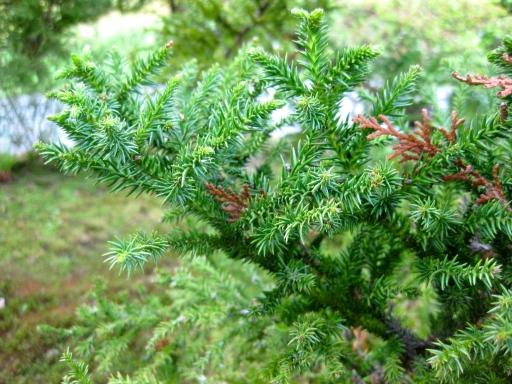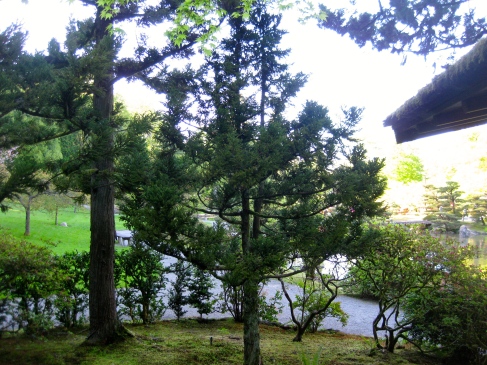Cryptomeria • Japanese Cedar • スギ • 杉 • sugi
SJG has cryptomeria in several areas: A.S, T, U, W. This particular one grows in northwest end of roji (Tea House Garden, Area W), and it’s marked as the ‘slowest growing dwarf’.

SJG • 5/3/13 – Cryptomeria japonica ‘Jindai-Sugi’ • Japanese Cedar, Area W (Tea House Garden) – up close
From wikipedia: Cryptomeria is a monotypic genus of conifer in the cypress family Cupressaceae, formerly belonging to the family Taxodiaceae. It includes only one species, Cryptomeria japonica (syn. Cupressus japonica L.f.). It is endemic to Japan, where it is known as Sugi (Japanese: 杉). The tree is often called Japanese cedar in English, though the tree is not related to the true cedars (Cedrus). […]
From Missouri Botanical Garden: […] Noteworthy Characteristics: Japanese cedar is a slender, pyramidal, evergreen conifer with tiered horizontal branching that is slightly pendulous at the tips. It is native to forested areas in Japan and China where it grows as a single trunk tree to as much as 150’ tall with an 8’ trunk diameter. In cultivation in the U. S., it grows smaller, more typically to 50-60’ tall. Sharply-pointed awl-shaped, green to blue-green needles (to 3/4” long) are spirally arranged. Foliage may bronze in cold winters. Spherical fruiting cones (to 1”) appear at the shoot ends. Reddish-brown bark exfoliates in strips. This is a prized timber tree in its native habitat. Compact and dwarf cultivars are commonly sold in commerce. [..]
From The Gymnosperm Database: Distribution and Ecology: China and Japan. Var. japonica is native only to Japan, where it occurs naturally in pure and mixed stands from Kyushu to N Honshu at elevations to 400 m (Vidakovic 1991). The variety is also widely introduced for forestry in Taiwan and many provinces of mainland China. […]
Oldest: Certain trees are popularly thought to be over 1,000 years old and the “Jomon” is a time about 3,000 years ago. Some websites repeat an old and fanciful claim that the Jomon-sugi is 7200 years old, but there is no basis for this assertion; it is simply folklore. […]
Remarks: Name is derived from the Greek kryptos=hidden, and meros=part (Vidakovic 1991). The meaning of this is unknown to me. […]


